By default the Component Builder shows the most common Joyo kanji components (ie, components which are themselves Joyo kanji, or which are used in at least three other Joyo kanji). Select an alternative ready of components below.
For details of all components and their English names, meet the Component collections.
To find any kanji, first try to identify the components it is made up of. One time you have identified any component, search for it in whatever of three means:
- Draw it in the drawing area
- Type the name in the text area
- Look for it in the list
Example: look up 漢
- Notice that 漢 is made of several components: 氵 艹 口 夫
- Describe whatsoever of these components (ane at a time) in the cartoon area, and select it when you come across it
- Alternatively, look for a component in the list. 氵 艹 口 each accept iii strokes; 夫 has four strokes
- If you know the meanings of the components, type any of them in the text area: water (氵), grass (艹), oral fissure (口) or husband (夫)
- Keep adding components until you can see your kanji in the list of matches that appears nearly the top.
The Kanshudo Component Architect can recognize whatsoever of the 416 components listed in the chart below the drawing area. Tips:
- Draw a component in the center of the area, as large equally you tin can
- Try to draw the component equally it appears in the kanji y'all're looking up
- Don't worry nigh stroke order or number of strokes
- Don't describe more i component at a fourth dimension
Non finding your component?
If you lot believe you've drawn your component correctly but the system is not recognizing information technology, delight:
Kanshudo
The Kanshudo complete guide to writing Japanese
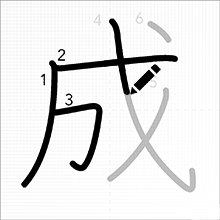
Kanshudo'due south guide to writing Japanese
In this guide you'll acquire the standard strokes used to draw all Japanese kanji, how to decide the stroke club for a kanji, the differences between printed and handwritten forms of kanji and more! In improver there are plenty of links to our kanji drawing practice tool so y'all can perfect your own writing style.
×
PDF version

Go a beautifully formatted PDF version of this article, consummate with all images, and with links to live drawing exercise on Kanshudo.
The PDF version is free for Kanshudo Pros.
Contents
i. Why acquire to write Japanese?
One of the virtually common questions nosotros hear is 'why learn to write kanji?'. Later all, computers and smartphones are nearly universal, and make it extremely like shooting fish in a barrel to draw whatever character you lot need to. Fifty-fifty if you have to create a handwritten annotation, it's easy to utilise a device to expect upward the kanji first if you lot need to.
Our respond is very simple: learning to write kanji volition cement them in your retentiveness more effectively than whatsoever other arroyo. If yous can actually summon to mind the components of a kanji, and reproduce them on paper by hand, we can pretty much guarantee that you will not forget that kanji. Purely recognition-based approaches are a peachy kickoff step, and they are fast and constructive, but writing invokes 'musculus memory' - information technology uses an entirely different part of your brain, which then works in tandem to complement the part of your brain that handles recognition. In the aforementioned way that speaking Japanese also improves your listening skills, learning to write will assistance you to read.
Learning a linguistic communication effectively (and efficiently) needs a holistic approach - you lot take to piece of work on reading, listening, speaking and writing in parallel. Learning to write will help you master the kanji, and Japanese, more quickly and finer.
2. The standard strokes used to draw kanji
The adept news is that all kanji, fifty-fifty the incredibly complex ones, are actually but combinations of the same set of standard strokes. If you lot larn and practise each of these basic strokes by writing simpler kanji that use them, you will soon start to run across how more complex kanji are built upward. In turn that volition enable you to see how to describe any kanji.
What is a stroke, and why does it matter?
By 'stroke' ( てんかく しょどう
The standard strokes
The listing beneath shows the 23 strokes that brand up all Jōyō kanji, along with example kanji that use them. Each example is linked to the drawing do page for that kanji (see Department half-dozen for information on how to use the drawing do tool). The dots point where you start drawing the strokes.
Some 'gotchas'
In general strokes that announced the same are drawn the same way whenever they are used. However, there are exceptions. For case, the curt stroke that appears on the top left of 牛 (cow) is usually written from superlative to bottom, only is occasionally written from bottom to top, for case equally it is used in the lower part of 扌 (the component form of 手, mitt).
How standard is standard?
In that location is actually no completely standardized definition of the different strokes in apply, and as a event there is no agreed count of the number of possible strokes. Many strokes are written in slightly different ways in different kanji, and some scholars consider these variations of a unmarried stroke type, where others consider them different strokes. However, this debate is not too important, and you will soon come to recognize the distinguishing features that enable you to separate one kanji from another.
3. Determining kanji strokes and stroke order
As a beginner information technology can seem nearly impossible to discover some kanji at outset, and just later practice y'all notice that you were 'drawing it wrongly', and equally a effect had miscounted the number of strokes.
Nevertheless, the good news is that the vast majority of kanji tin can exist cleaved down into the correct strokes in the right order using a few uncomplicated rules. Here they are! As with all rules worth their salt, every one of these has exceptions, but these rules will piece of work 90% or more of the time.
1. Start horizontal strokes starting time (from the left) then vertical strokes (from the superlative)
Horizontal strokes are drawn left to right, and vertical strokes are drawn peak to bottom. Diagonal strokes virtually e'er start at the top. Generally, horizontal strokes are fatigued earlier vertical strokes (although rule 3 leads to exceptions).
Practice drawing: 一 十
ii. Draw strokes that first at the acme left start, and work towards the bottom right
Choose strokes with starting points nearest the height left first. When two or more strokes kickoff at the aforementioned point, choose the ones that go towards the bottom left earlier ones that become towards the bottom right (and so that yous finish in the bottom right). In that location are ii exceptions to this dominion: (a) strokes which bridge the whole kanji, crossing other strokes, which are normally drawn last in their component (meet dominion v), equally in the top of 書, and (b) dots and other minor strokes, which are typically drawn last of all, as in the dot in 玉.
Practice drawing: 二 文 書 玉
3. Draw elements that give vertical symmetry before symmetrical elements
Kanji often incorporate vertical strokes that provide vertical symmetry, and then multiple like elements on either side. Draw the vertical strokes first, followed by the symmetrical elements (left to right), as in 木 or 水. Even so, when there are multiple groups of symmetrical elements, the first group is drawn, then the vertical stroke, then the next group (every bit in 来).
Practice drawing: 水 木 来
iv. Lookout man for combined horizontal / vertical strokes
Every bit you can see from the standard strokes list, some stroke types are created by combining other simpler strokes. It is possible to create some shapes using unlike combinations of standard strokes, and this is the most mutual source of 'stroke counting' problems. Unfortunately, this is a flake irregular. However, a expert guideline is that a horizontal followed by a vertical is generally combined - equally in 日. If that combination is not possible, a vertical followed by a horizontal might exist combined - every bit in 断. Sometimes (but rarely enough it'due south easy to spot), more than two strokes may be combined, as in 凸凹.
Practice cartoon: 日 断 凸 凹
v. Draw components separately, starting with the ones 'inside' or on the tiptop left
As you volition know if y'all are following the Kanshudo method of learning kanji, most kanji are composed of two or more components. In general, identify these components, and draw them in club following the same rules as you lot would as if each component was a stroke: top to lesser, left to right.
Some components 'comprise' other components, and they need to be handled a piddling differently. In the case of ⻌ (the move radical), the components it 'contains' are always drawn kickoff. In the instance of 囗 (box, enclosure), you draw the top and sides first, so the component inside, then the bottom. This approach also applies to other components such as 匚.
Practice drawing: 思 道 四 区
Worked case: 鬱
Given the rules in a higher place, let'due south take a look at one of the about circuitous kanji out at that place - the kanji with the most strokes in the Jōyō (29): 鬱.
- Beginning permit'south see what components 鬱 contains. It is pretty complicated! It has several: 缶, 林 (or 木 on either side), 冖, a complex slice 鬯 which in itself could be made up of other elements, and finally 彡.
- So, allow'southward commencement with dominion 5 to help usa figure out the order of components to describe: symmetry kickoff (缶), and then the 木 on either side, and so another symmetrical component 冖, then the left side 鬯 and 彡. None of these are 'containing' components, so we tin just draw each ane by one. This is already looking more straightforward!
- Allow'south accept 缶. This is mostly straightforward: nosotros start with dominion 2 which shows us we starting time at the top left with our fiddling diagonal stroke. Rule 1 then tells u.s. to do the two horizontals, followed past the vertical. At present things get tricky: in fact the bottom of this component is only two strokes, a 'shelf' and another vertical.
- Side by side we describe our ii copse. Rule i tells that we do our horizontal kickoff, followed past the vertical. Rule 2 tells u.s.a. to do the left diagonal followed by the correct diagonal.
- Next we take 冖: in that location are actually two challenges here - we draw the left side vertical first, and and so the horizontal and the right vertical every bit a combined element.
- Next nosotros go to 鬯. This is actually a radical (standard component) in Chinese, which uses a longer radical list than Japanese. However, in Japanese it is extremely uncommon. Stroke order is adequately standard, though, if yous remember to use rule 3 several times, as that shows you how to determine what orde to practice the strokes in the castor.
- And 彡 is a prissy piece of cake one to finish: rule 1 tells us we draw our strokes pinnacle to bottom, and each stroke starts at the top.
Practice cartoon: 鬱 缶 林 木 冖 鬯 彡
4. Hiragana and katakana
Hiragana and katakana began their existence as kanji, then generally speaking they follow similar rules.
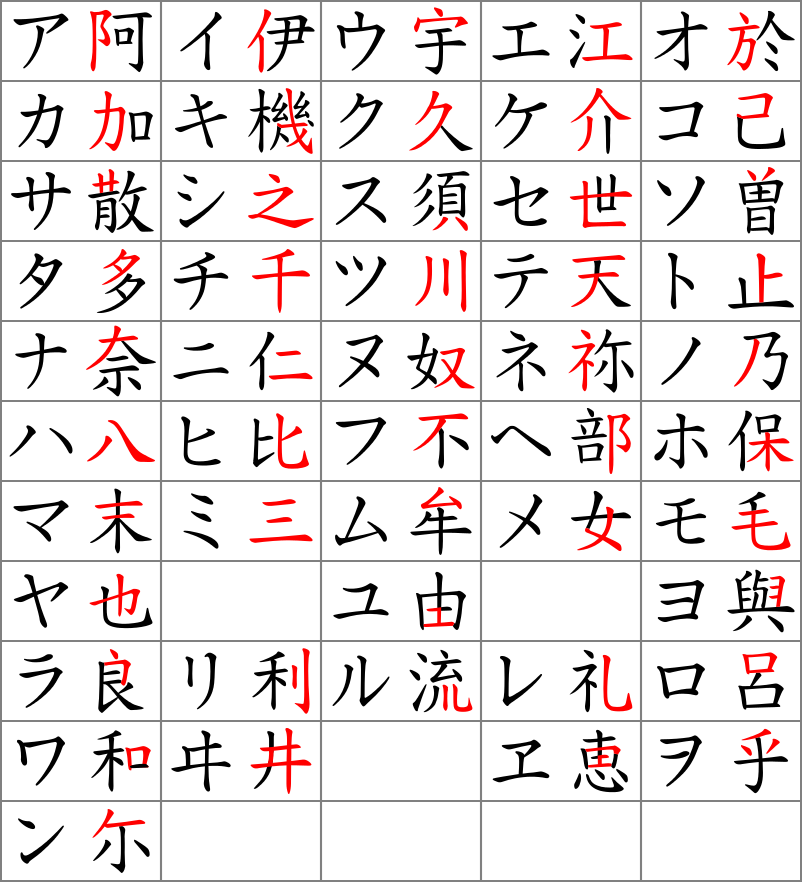
Katakana characters in detail were created by taking elements of kanji - for instance, katakana カ originally came from 加, and the stroke order is unchanged.
All the same, hiragana characters were created equally simplifications of the kanji they derive from. For example, although hiragana か was also derived from 加, the 口 on the right remains, but simplified to a single dash. This simplification changes stroke types and sometimes order abroad from the original.
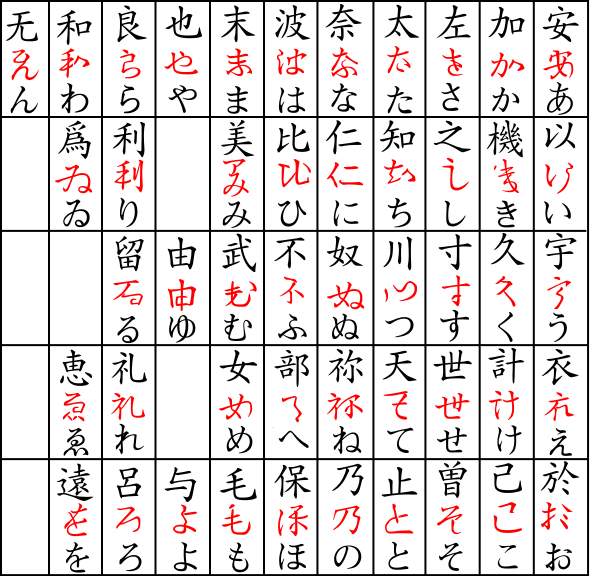
To set up your Japanese and kanji studies off on the right pes, at that place is no shortcut to learning the hiragana and katakana thoroughly. Outset with Kanshudo'south guides, which provide an introductory explanation, drawing practice, and links to free flashcards: hiragana, katakana.
v. Handwritten vs printed Japanese
As you lot can see from the chart illustrating the origin of hiragana above, handwritten Japanese characters can behave little obvious relation to their typeset equivalents! While かいしょ
For non-native Japanese learners, fully cursive writing, known as そうしょ
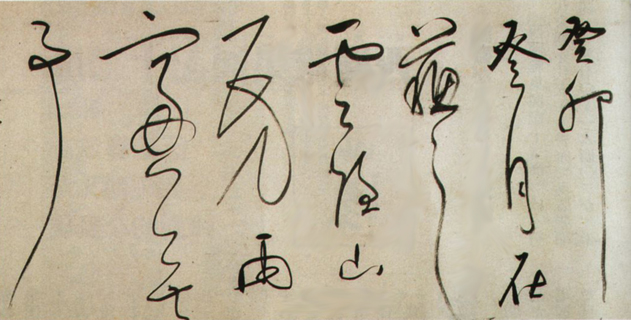
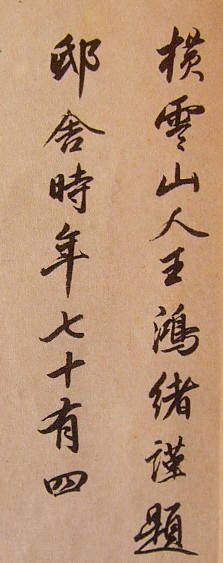
Nearly Japanese write kanji on a daily basis in an intermediate semi-cursive form known as ぎょうしょ
In this example, it's much easier to make out the original characters, although still not picayune. This one says 横雪山人王鴻緒謹題 邸舎時年七十有四.
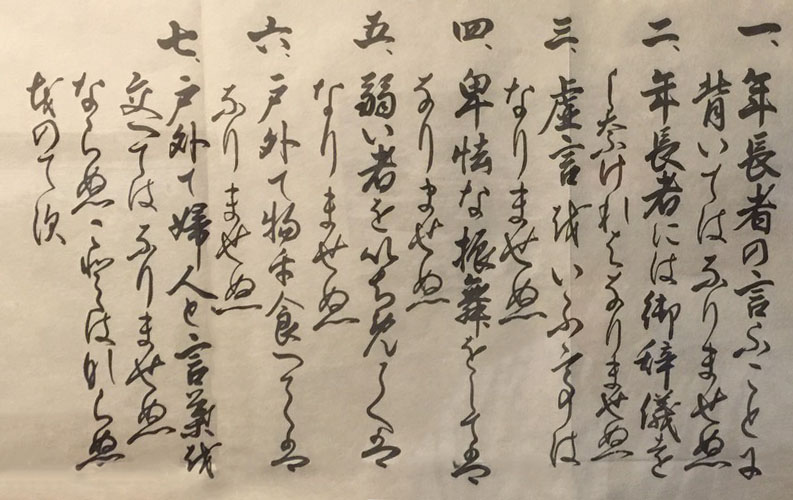
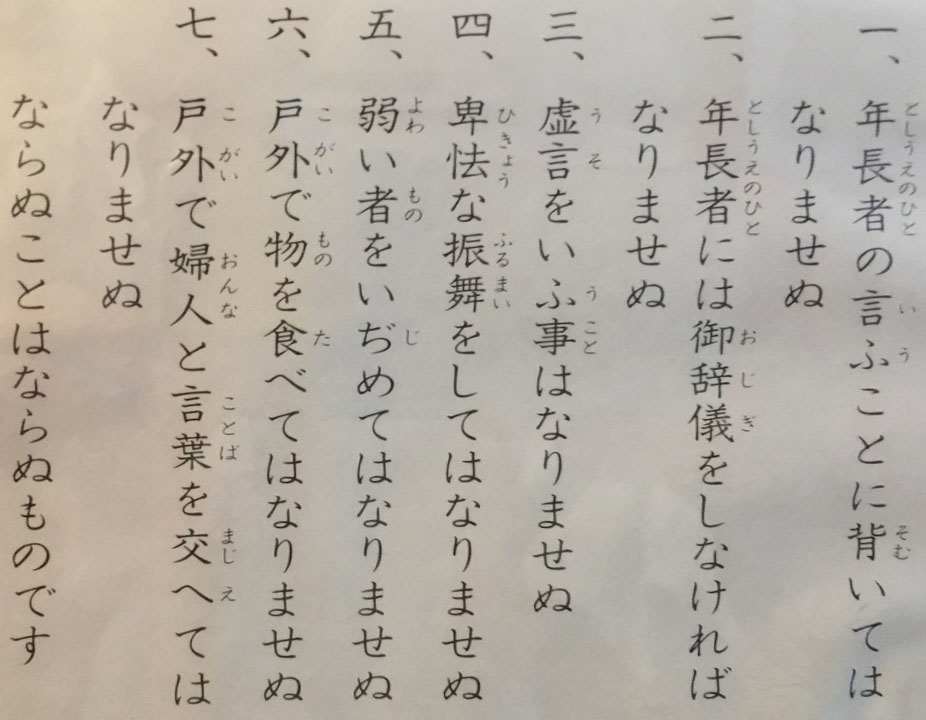
Source: poster on onsen wall in Nakanosawa, almost Inawashiro Machi (via Larry Richards)
This example includes the original text as well equally the modern Japanese version. It's likewise a good illustration of two additional challenges reading cursive script. First, a lot of cursive writing uses older Japanese. In this instance, note how the negative verbs end with ぬ instead of ん, and note how 言う is written using ふ. Second, discover how the script version of ぬ has a squiggly line beneath it, like the line in the obsolete hiragana 'nosotros': ゑ. In the early days of hiragana, alternative versions of several characters co-existed, based on different source kanji. Today'southward hiragana ぬ is derived from 奴, but originally another version circulated that was based on 怒, and that's what you lot come across here. These alternative versions of hiragana are known equally 'hentaigana'.
Learning to read cursive Japanese
Unfortunately, there is no magic path to this! The only real solution is lots of practice. You need to know components well plenty that yous tin can recognize them from the 'suggestions' in the handwritten forms, and then y'all know demand to know the kanji well enough that you lot tin can bring to mind various kanji that utilise components you can recognize. All this is greatly complicated by the fact that handwritten Japanese may draw on a much larger range of kanji than the Jōyō. But, fear non! Reading handwritten Japanese is a rare requirement as a beginner, and if y'all are stuck, there are enough of tools to help - come across ref. (4) for some pointers.
vi. Kanshudo's kanji drawing practice organisation
Additionally, you lot tin can use Kanshudo to exercise cartoon whatsoever kanji or component you find anywhere on Kanshudo. Our practice tool lets you depict independently, or superimpose your drawing on a reference image of the kanji for comparison.
To exercise drawing a kanji, first look it upwards, for instance using Quick Search. Scroll down to the blue 'cascading kanji' view of each kanji and its components. Click on the kanji for more details, and click on the Depict link to bring upward the drawing practice tool. You lot can also notice a link to drawing practice from the details page of whatsoever kanji - for example 漢 details. If you subscribe to the Daily Kanji, your daily email will also contain a direct link to cartoon practice.
Once you're in the drawing tool, simply commencement drawing! Utilise the case on the left as a reference. At any time yous can click Bear witness reference to see the aforementioned case superimposed on the drawing grid. Clear my drawing will reset your cartoon. Clear last stroke just removes 1 stroke at a time. The reset button will clear all your strokes likewise as the reference image.
7. Kanji Depict - the game
When you are ready, play a few rounds of Kanji Draw, our kanji drawing game. You tin can play Kanji Draw with any kanji report set, kanji with any usefulness level (or range of levels). You can also restrict Kanji Draw based on your own kanji mastery level. Play a game in high score mode and track your progress!
8. Farther reading
- There are many analyses of Chinese grapheme strokes. One sensible reference point is the Unicode specification, which defines a 'block' of characters representing strokes. Currently 36 strokes are included, simply if you examine the list you will see several which are extremely similar - for example, Unicode defines a dissever character for a brusque diagonal stroke depending on whether it goes from left to right or right to left. Encounter https://en.wikipedia.org/wiki/Stroke_(CJKV_character).
- For more than on Japanese calligraphy, first with Wikipedia'south article on the different scripts: https://en.wikipedia.org/wiki/Cursive_script_(East_Asia).
- See hither for an example of fonts that produce cursive Japanese.
- 1 great tool is Mojizo, a organisation for recognizing cursive kanji from images. Kanshudo's own component builder (how to guide) is a style to find kanji quickly based on any components you lot recognize, and information technology includes our own AI tool for recognizing hand-drawn components.
Kanshudo is your AI Japanese tutor, and your constant companion on the road to mastery of the Japanese language. To become started learning Japanese, just follow the study recommendations on your Dashboard. Yous can use Quick search (attainable using the icon at the summit of every folio) to wait upward any Japanese word, kanji or grammar point, too as to observe anything on Kanshudo quickly. For an overview, take the tour.
The Kanshudo kanji usefulness rating shows you how useful a kanji is for you lot to larn.
has a Kanshudo usefulness of , which means it is among the almost useful kanji in Japanese.
is one of the 138 kana characters, denoted with a usefulness rating of K. The kana are the most useful characters in Japanese, and we recommend you lot thoroughly acquire all kana earlier progressing to kanji.
All kanji in our system are rated from i-8, where 1 is the most useful. The 2136 Jōyō kanji have usefulness levels from 1 to 5, and are denoted with badges like this:
The 138 kana are rated with usefulness K, and have a badge like this:
The Kanshudo usefulness level shows you how useful a Japanese give-and-take is for yous to learn. has a Kanshudo usefulness level of , which ways it is amid the most useful words in Japanese.
All words in our system are rated from i-12, where 1 is the most useful. Words with a usefulness level of nine or better are amidst the almost useful 50,000 words in Japanese, and have a colored badge in search results, eg:
Many useful words have multiple forms, and less common forms accept a bluecoat that looks like this:
The JLPT (Japanese Language Proficiency Test, 日本語能力試験) is the standard test of Japanese language ability for non-Japanese. would beginning come up in level Northward .
Kanshudo displays a bluecoat indicating which level of the JLPT words, kanji and grammar points might first be used in:
indicates N5 (the first and easiest level)
indicates N1 (the highest and most hard)
You lot tin can use Kanshudo to report for the JLPT. Kanshudo usefulness levels for kanji, words and grammer points map directly to JLPT levels, and so your mastery level on Kanshudo is a direct indicator of your readiness for the JLPT exams. Kanshudo usefulness counts up from 1, whereas the JLPT counts downwardly from 5 - then the first JLPT level, N5, is equivalent to Kanshudo usefulness level .
The JLPT vocabulary lists were compiled by Wikipedia and Tanos from past papers. Sometimes the form listed by the sources is not the about useful form. In instance of dubiousness, we advise y'all to learn the Kanshudo recommended form. Words that appear in the JLPT lists in a different form are indicated with a lighter colored 'shadow' bluecoat, like this: .
DOWNLOAD HERE
How to Draw Japanese Characters Step by Step TUTORIAL
Posted by: bettysenguen.blogspot.com